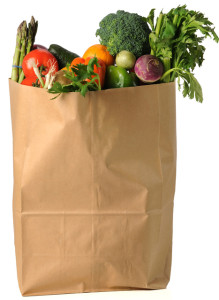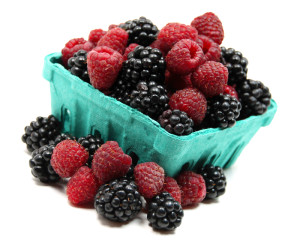Low-Calorie Foods That Are Rich in Nutrients
It’s important that most of your diet consists of foods that will contribute to your complete nutrition needs. When they are low-calorie, this can aid in weight loss.
If you’re aiming to eat healthier to lose weight, you’ll want to include plenty of low-calorie foods that are high in nutritional value in your diet plan. Fortunately, almost all non-starchy vegetables and fruits are low-calorie foods, so you have a large selection from which to choose.
Vegetables | Fruits | Protein | Snacks
Low-Calorie Foods: Vegetables
From asparagus to zucchini, a wide array of vegetables should appear in your reduced-calorie diet plan. Here’s a list of popular vegetables that provide less than 60 calories per one-cup serving:

Low-calorie diet? Go a little crazy when you get to the vegetable section; try different combinations to keep variety in your diet.
- Asparagus
- Broccoli
- Carrots
- Cauliflower
- Celery
- Cucumber
- Eggplant
- Green beans
- Kale
- Lettuce (all varieties)
- Mushrooms
- Spinach
- Sweet peppers
- Tomatoes
- Yellow (crookneck) squash
- Zucchini
Many of these low-calorie foods have a high water content, which means that they can help you maintain an adequate fluid intake. Many vegetables are also good sources of fiber, which helps satisfy your appetite as well as providing numerous health benefits.
Starchy vegetables—including potatoes, winter squash, beans, corn, and peas—are good sources of many nutrients. However, they contain more calories (most have between 100 and 160 calories per cup) than non-starchy vegetables, so limiting your consumption of these foods and keeping portions under control may support your weight-loss efforts.
Low-Calorie Foods: Fruits
Most fruits are higher in calories than vegetables since they contain natural sugars, but they are still considered low-calorie foods. If you buy frozen or canned varieties, be sure to choose products that contain no added sugar. Fruits that provide less than 70 calories per one-cup serving include:

Raspberries and blackberries are among the fruits that provide fewer than 70 calories per one-cup serving.
- Apples
- Blackberries
- Cantaloupe
- Honeydew
- Mangos
- Papaya
- Peaches
- Raspberries
- Strawberries
Fruits that fall in the 71- to 100-calorie range per one-cup serving include blueberries, sweet cherries, grapefruit, grapes (red or green), oranges, pears, pineapple, and plums. Although these fruits may rank a little higher on the calorie counter, they’re still worthy choices, since they provide plenty of vitamins, minerals, and other nutrients.
Like vegetables, fruits contain fluids and fiber, and they have an added bonus: Their natural sugar content makes them an excellent alternative to sugary, high-calorie desserts when you’re craving something sweet.
Keep It Balanced
Even when you’re losing weight, it’s important to make sure you’re following an overall healthy eating plan that includes some foods that are higher in calories but are good sources of important nutrients, such as healthy fats and protein.
For example, nuts contain healthy, unsaturated fats as well as protein and fiber, and many healthy diet plans recommend eating nuts a few to several times per week. However, limit yourself to no more than one serving a day, since a quarter-cup runs from 160 to 200 calories, depending on the type of nut. Vegetable oils, including olive, flaxseed, canola, soybean, and corn oils, are another source of healthy fats, but all oils contain about 120 calories in one tablespoon, so use them sparingly.
Although fat was once regarded as an “enemy” if you were trying to lose weight, fat is no longer a forbidden food. In fact, research has shown that including healthy, unsaturated fats in an overall healthy diet plan can aid weight loss.
Fat has a high satiety factor—it helps you achieve the feeling of fullness that tells your brain it’s time to stop eating. Eating small amounts of fat with other foods will also help you absorb fat-soluble vitamins (A, D, E, and K).
Low-Calorie Foods: Protein
Your healthy eating plan also needs to include some lean protein. Protein provides the amino acids that are used as building blocks for all of the cells in your body. Studies have shown that eating protein helps you feel full more quickly, which can help with appetite control.
Good protein sources (if they’re steamed, baked, or broiled with little or no fat or breading) include:
- Most fish, including ocean perch, cod, haddock, halibut, mackerel, bass, catfish, grouper, snapper, flounder, salmon, and tuna
- Most shellfish, including oysters, crab, shrimp, and scallops
- Skinless, white-meat chicken and turkey
- Lean cuts of beef (tenderloin, top sirloin, top round, bottom round)
- Lean cuts of pork (tenderloin, bone-in sirloin roast, boneless top loin chops and roast)
- Eggs
- Beans, peas, and lentils
- Soybean products, including tofu and tempeh
Low-Calorie Foods: Healthy Snacks
If you’re always hungry when you’re trying to lose weight, keep snacks on hand that combine low-calorie fruits or vegetables with some protein and healthy fat.
Healthy snacks to keep your hunger at bay include:
- 1 cup of celery sticks (16 calories) or sliced cucumbers (14 calories) with 2 tablespoons of hummus (40-70 calories; check Nutrition Facts label on product package)
- 1 cup of red bell pepper slices (29 calories) or sliced zucchini (29 calories) with ¼ cup of homemade black bean dip (70 calories; see recipe in sidebar box)
- 1 cup of apple slices (57) with 1 tablespoon of natural peanut butter (100 calories) or almond butter (95 calories)
- 1 cup of cubed cantaloupe (54 calories) or watermelon (46 calories) with ½ cup of low-fat plain yogurt (71 calories)
Bottom line: Include plenty of low-calorie foods, especially vegetables and fruits, in your diet. When you choose foods that are higher in calories, make sure that they are meeting your complete nutrition needs if you want to avoid putting on extra pounds.
RECIPE FOR BLACK BEAN DIP
- 1 (15-oz) can no-salt-added black beans, including liquid
- ½ teaspoon cumin
- ¼ teaspoon garlic powder
- a few pinches of salt
- 1/8 teaspoon black pepper
- 1 teaspoon lime or lemon juice, freshly squeezed
- ¼ teaspoon hot sauce (such as Tabasco), or to taste
- 2 teaspoons olive oil
Yield: About 8 (1/4-cup) servings, 70 calories per serving
Put beans, cumin, garlic powder, salt, black pepper, and hot sauce in the bowl of a food processor. Drizzle in olive oil; process until ingredients are thoroughly combined. If mixture is too thick, add a teaspoon of water at a time until desired consistency is reached.
Extra tips:
- If you can’t find canned beans that contain no added salt, drain and rinse the beans thoroughly before using them, and add 2 tablespoons of water to the bowl before processing.
- If you don’t care for black beans, substitute your favorite type of bean: kidney, navy, cannellini, fava, Great Northern, garbanzo, and pinto beans will work just as well.
- If you don’t have a food processor, use a blender.
- To add color and more flavor to the dip, stir in 1 tablespoon fresh, chopped flat-leaf parsley, cilantro, or basil.
Originally published in 2016 and updated.


 Ask the EN Experts March 2025
Ask the EN Experts March 2025  Vegan Diet Better Than Omnivore Diet for Cardiovascular Health
Vegan Diet Better Than Omnivore Diet for Cardiovascular Health 
Some low-calorie foods can also offer high nutritional value.
© Iqoncept | Dreamstime.com